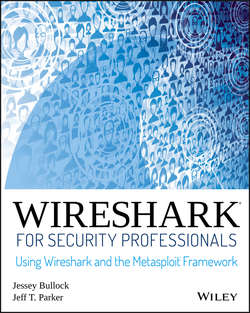Читать книгу Wireshark for Security Professionals - Parker Jeff T. - Страница 4
На сайте Литреса книга снята с продажи.
Chapter 1
Introducing Wireshark
What Is Wireshark?
ОглавлениеWireshark, in its most basic sense, is a tool to understand data you capture from a network. The captured data is interpreted and presented in individual packet form for analysis, all within Wireshark. As you probably already know, packets are the chunks of data streaming on a network. (Technically, depending on the context level of where in the system the data is interpreted, chunks are called frames, datagrams, packets, or segments, but we'll just use “packets” for now.) Wireshark is a network and protocol analyzer tool, free for download and use on a variety of platforms, spanning many flavors of Unix and Windows.
Wireshark first captures the data from a network interface and then breaks the capture into the frames, segments, and packets, understanding where they begin and end. Wireshark then interprets and presents this data in the context of addressing, protocols and data. You can analyze the captures immediately or save them to load later and share with others. In order for Wireshark to view and capture all packets, not just those involving the capturing system, the network interface is placed in promiscuous mode (also called monitor mode) in the context of capturing on a wireless network. Finally, what grants you the ability to analyze packets in Wireshark are the dissectors. All these basic elements are discussed in more detail in Chapter 4, in the context of “sniffing” or capturing data, and how that captured data is interpreted.
A Best Time to Use Wireshark?
Wireshark is an immensely powerful tool with quite a bit of deep and complex functionality. It is capable of handling a wide range of known (and unknown) protocols. But although the functionality range is broad, most of it aligns to one end: to capture packets and analyze them. Being able to take the bits and bytes and present them in an organized, familiar, and human-readable format is what brings people to think of using Wireshark.
Before launching Wireshark, it's important to understand when to use it and when not to use it. Sure, it's a great tool, but like any tool, it's best used when it's the right tool for the job.
Here are scenarios when it's ideal to use Wireshark:
• To look for the root cause of a known problem
• To search for a certain protocol or stream between devices
• To analyze specific timing, protocol flags, or bits on the wire
And while not ideal, Wireshark can also be used:
• To discover which devices or protocols are the top talkers
• To see a rough picture of network traffic
• To follow a conversation between two devices
You get the idea. Wireshark is ideal for determining a root cause of an understood problem. While not ideal for browsing network traffic or making high-level judgments about the network, Wireshark does have some features to show those statistics. But Wireshark can't and shouldn't be the first tool thought of early on in discovering a problem. Someone who opens Wireshark to skim through the list of packets to assess network health would soon be overwhelmed. Instead, Wireshark is for problem solvers, for the detectives who already know their suspects well.
Avoiding Being Overwhelmed
The majority of people who walk away from Wireshark do so because they find it overwhelming after only a few early experiences. To label Wireshark as overwhelming is misleading, however. What really paralyzes new users is the traffic, the list of packets flying by, not the application's functionality. And, fair enough, once you start a capture and the packets scroll by in real time, it's definitely intimidating. (But that's what filters are for!)
To avoid being overwhelmed, consider two aspects of Wireshark before diving into it:
• The interface– how it's laid out and why
• Filters– how they work to reveal what you want
Once you get a quick appreciation of the tool's interface and how to write a filter, Wireshark suddenly appears intuitive and shows its power, without the scare factor. And that's what we focus on for the rest of this chapter.
The following sections are on the most important aspects that you need immediately to be comfortable using Wireshark. If you are already familiar with Wireshark, as well as filters, feel free to skim this chapter as a refresher so that you can be sure you are on the same page for the rest of the book.
